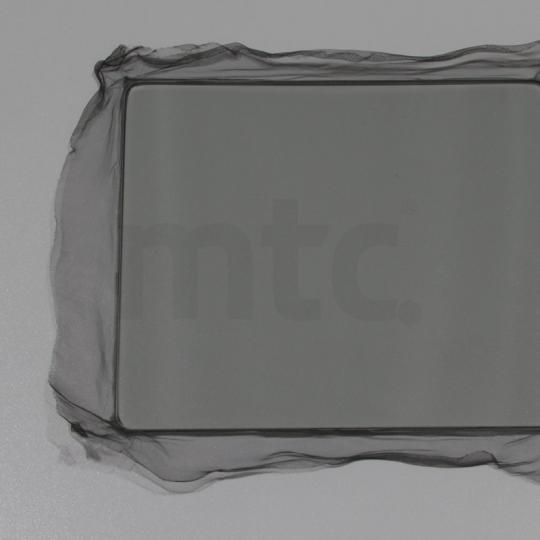* silver plated and blackened
Overview Fully laminated mesh window
Contact with the housing
Two substrates and an electrically conductive metal mesh are laminated together The mesh stands over the edge and can be connected directly to the chassis or it also can be done in combination with an electrically conductive gasket.
Selection of the base material:
- glass (Float-, heat treated- and chemical toughened glass)
- acrylic glass
- polycarbonate glass
The following combinations are possible:
- glass / mesh / glass
- plastic / mesh / plastic
The very best shielding attenuation can be reached with fully laminated windows. Glass is scratch resistant and plastic is break proof.
Prior the lamination of the mesh the orientation of the mesh should be determined. In some applications a lamination at 90° can cause interferences with the display (so called Moire effect).
To avoid reflections and to improve the contrast, the fabrics are generally blackened. This process does not modify the electrical conductivity of the fabric.
The aperture size of the mesh (opi = openings per inch) affects the transparency of the window. If there is a high-resolution graphic used in the application, the use of a fabric is not recommended. In this case an electrically conductive metallized substrate should be used.
Variety of meshes
| Blackened mesh | opi | Wire-Ø in mm |
|---|---|---|
| 100 | 0,05 | |
| 50 | 0,025 | |
| * | 100 | 0,025 |
Attenuation (dB)
| 0,01 MHz | 0,1 MHz | 1,0 MHz | 100 KHz | 1,0 MHz | 10 MHz | 100 MHz | 400 MHz | 1,0 GHz | 10 GHz | |
|---|---|---|---|---|---|---|---|---|---|---|
| H-field | H-field | H-field | E-field | E-field | E-field | E-field | E-field | P-field | P-field | |
| Option 1 (single layer) | 3 | 7 | 21 | 98 | 93 | 78 | 65 | 60 | 50 | - |
| Option 2 (two layers) | * | * | * | 123 | 152 | 124 | 111 | 115 | 94 | 67 |
* We have not tested double mesh windows at this frequency.
Option 1 refers to a single layer of mesh 100 opi blackened copper 0.05 mm wire diameter.
Option 2 refers to two layers of mesh 100 opi blackened copper 0.05 mm wire diameter.
Test methods and procedures in accordance to MIL-Std 285.
Test results base on a RFI shielded window size 1000 x 1000 mm.
Antireflection
To prevent unwanted reflection of light it is suggested to add an antireflection coating to the substrate.
Possibilities at mineral glass:
- Multi-layer coating according to MIL SPEC 675 B (less than 0,6% rest of reflection)
- Single-layer coating according toDIN 58197 (less than 1,5% rest of reflection)
- Chemical etching:
5% anti reflection (called GW 80)
9% anti reflection (called GW 100)
13% anti reflection (called GW 120)
Possibilities at plastic:
- Multi-layer coating according to MIL SPEC 675 B (less than 0,6% rest of reflection)
- Single-layer coating according to DIN 58197 (less than 1,5% rest of reflection)Chemical etching (very diffuse)
- Chemical etching (very diffuse)
- Anti-scratch, anti-reflection coating by spraying




